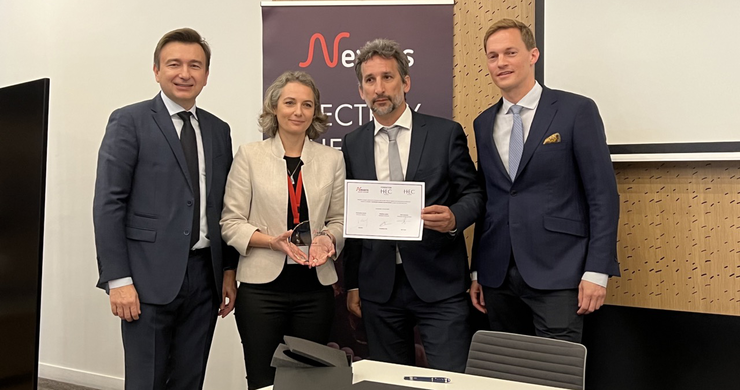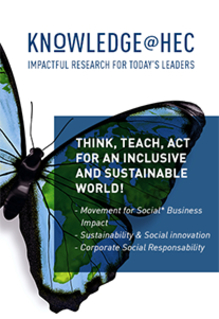At HEC Paris in September 2023, you began your lecture to the new students by explaining the importance of a long-term vision… Could you elaborate?
Every day, managers suffer from paradoxical injunctions. They hear about volume vs. value, growth vs. sobriety, and productivity vs. scarcity... So we have developed a new systemic operating model by merging ideas from the traditional Chinese long-term vision and a 10-year plan with a clear purpose: to electrify the future, but only through renewable energies. We entered a permacrisis era where no one can predict the next crisis coming. In such an unpredicted world, short-term business plans are never reliable. What really matters is a long-term vision because you can adapt to perpetual crises while maintaining the long-term vision, the final arrival objective.
How do you align economic and environmental goals?
We cannot manage a listed company nowadays in the same way we did in the past decades. The world has changed, and the management needs a deep transformation. Obsession over volume and growth is obsolete. Leading a listed company requires us to answer the paradoxical injunction to generate profit and cash flow while reducing the environmental impact and natural resources needed to manufacture our products.
Leading a listed company requires us to answer the paradoxical injunction to generate profit and cash flow while reducing the environmental impact and natural resources needed to manufacture our products.
Hence, each year, we establish not only profitability targets but also carbon reduction quotas. Achieving this dual objective without pursuing growth compels us to design products and seek clients and investors in a way that aligns with our goals. For example, together with our clients, we invest significantly in geophysical aspects to avoid encroaching upon protected areas and their biodiversity.
Evaluating our impact is essential, but we need to be careful with regulations. Regulation should help to reduce, not increase, complexity. Because complexity has a huge cost. In the EU, ESG encompasses 1,500 labels and 2,000 indicators but often without convergence or correlation. To counter this complexity, we emphasize to our managers that adopting a more systemic, long-term, and holistic approach with fewer indicators and greater simplicity is important.
Your priority in transforming your model has been reducing complexity costs through selecting clients. Can you explain how this approach has resulted in tripling profits?
The complexity of managing a company has recently increased significantly. Simplifying our operating model has amplified our impact, increased our profitability, and reduced our carbon footprint.
Simplifying our operating model has amplified our impact, increased our profitability, and reduced our carbon footprint.
How? We shortened nearly 30% of product references and withdrew almost 70% of clients from our portfolio. We have strategically chosen clients based on both strategic and environmental criteria, selecting those who maximize profitability and cash flow and align with our values. To facilitate this simplification and prioritization, we also invested in data analytics.
By serving fewer clients and delivering fewer products, we have completely freed our supply chain. Production times have been reduced by 3, and delivery times by 8.
Since 2018, margins have doubled, returns on capital employed have increased from 9 to 21%, and cash flows have multiplied by five. Despite reduced turnover and volume, we have achieved record EBITDA (325 million in 2018, 665 million in 2023), while reducing, in the same period, our carbon employed of almost 40%.
In L'Entretien HEC, you say that Nexans has recycled 20,000 tons of cables, but this represents only 5% of the current supplies you need... How can one accelerate electrification and energy transition?
As a result of the changes just described, Nexans’ environmental footprint, as measured by CO2 emissions, has decreased by a third since 2019. Additionally, I aim to contribute to carbon neutrality by 2050. Developing circularity through cable recycling is the major challenge for the next 10 years, and it is inevitable. The wastes of today are the markets of tomorrow.
This is also a choice from our clients in the markets. In addition, all our cables made of aluminum utilize low-carbon aluminum, and we aim to replicate what has already been achieved in one of our Swedish units across all countries – a product made of 70% recycled material that is 100% recyclable.
How do you engage the staff on the company's purpose?
I hired sociologists to interview our workers, and from these interviews emerged the employees' values: the significance of heritage and contributing to the energy transition. We also identified and addressed the root causes of absenteeism and management practices that contributed to it. Thus, we are beginning to understand the best practices utilized by top managers.
We have embarked on a complete transformative journey. Because it doesn’t make sense to transform our operating model if, in the meantime, we do not work on collective and individual commitment via a clear purpose.
How do you work with Professor Sebastian Becker, who holds the Nexans Chair?
At Nexans, we have shown how to manage a company with a low ecological footprint while achieving high economic performance and fostering staff engagement, but we need to take it a step further. Therefore, my goal is to share experiences with professors and students from HEC Paris to reflect together and improve the model. Sebastian Becker created a teaching case on Nexans that allows professors in any institution to teach sustainable business transformation.
In essence, we believe that sustainability is achievable if we make long-term decisions, simplify production and supply chain costs, operate within the constraints of natural resources, and cultivate meaning in the workplace.
The world has changed, and no management book, class, or model has changed. Until HEC Paris decided to open the Chair. I believe it only makes sense if education is part of this systemic approach because the future managers HEC is educating need to be trained with this holistic operating model named E3.







